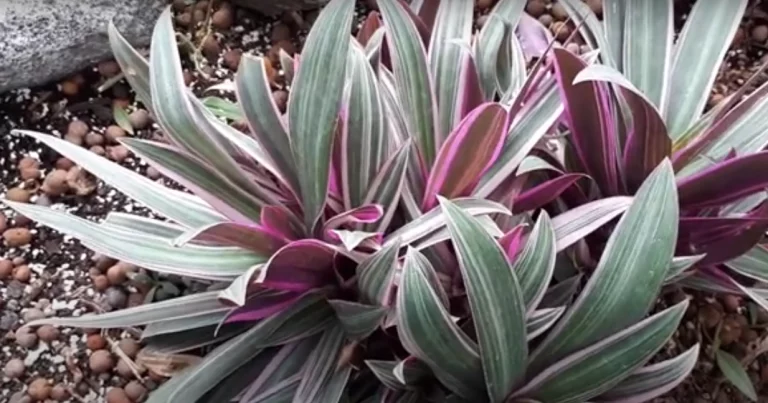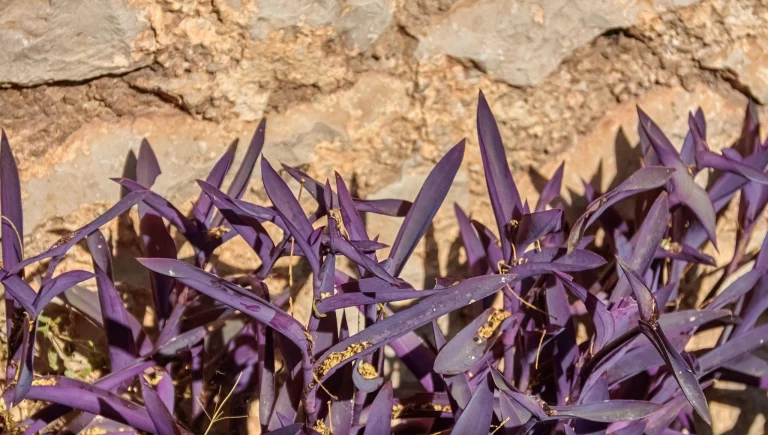Growing Tradescantia Blushing Bride; Expert Tips
Well hello there, my fellow house plant enthusiasts! I’m thrilled to be sharing my knowledge about one of my all-time favorite spiderwort varieties – the gorgeous Tradescantia blushing bride. I find this shapely perennial’s pink and white bicolor foliage simply irresistible.
Before we dive into the nitty gritty details of caring for this beauty, let’s get to know her better, shall we?
What is Tradescantia Blushing Bride?
Tradescantia blushing bride goes by several common names including blushing spiderwort, blushing maid spiderwort, and maiden’s blush. But no matter what you call her, this Tradescantia variety stands out from the crowd with her lush leaves decorated in blushing pink and pearly white tones.
Let’s talk taxonomy for a moment, shall we? The full scientific name is Tradescantia x andersoniana ‘Blushing Bride’ and she’s a member of the spiderwort family called Commelinaceae.
Within the Tradescantia genus, blushing bride belongs to the Andersoniana Group. This includes a lot of the most common spiderwort hybrids you’ll find at garden centers and nurseries. The parentage of blushing bride likely includes T. virginiana, T. subaspera, and possibly T. ohiensis – though hybrid origins can be murky sometimes!
Now back to this beauty’s fabulous foliage! Starting in spring, vivid pink color washes over the bases of the slim pointed leaves contrasting prettily with green. Then in summer, the leaves fade to solid green once mature. But with adequate moisture and bright filtered light, blushing bride will keep pumping out that pink new growth. A perfect balance means you get the best of both – lush green foliage dotted with blushing pink.
Doesn’t that just sound lovely? Now that we know exactly what makes this spiderwort so special, let’s get into the care and cultivation details!
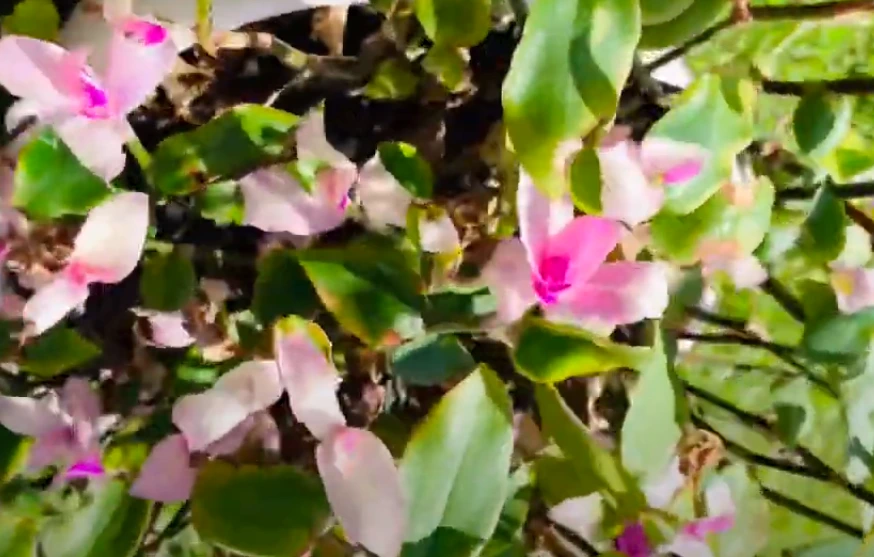
Tradescantia Blushing Bride Features
Now that we’re clear on exactly what a blushing bride spiderwort is, we can dive into all the fabulous features that make this plant such a jewel for gardens and homes. I find there’s so much to love about Tradescantia blushing bride!
Growth Habit
Let’s start by talking about this beauty’s growth pattern and overall structure. Tradescantia blushing bride is clump forming, meaning thick tufts of slender stems topped with pointed leaves emerge from the base. The stems range from upright to trailing, so blushing bride spiderwort takes on a mound shape close to the ground. Ultimately bundles of steam reach 12-18 inches tall and spread 1-2 feet wide.
You’ll also spot some thin, wiry roots protruding from the plant’s stems and undersides if you peek closely. These specialized roots, called adventitious roots, help blushing bride propagate and trail over nearby surfaces. So given the chance, blushing bride will happily wander beyond her initial planting area!
Overall the fine stems and tidy, grassy leaves give blushing bride spiderwort an airy, delicate look. But don’t be fooled by appearances – this beauty is persistent and spreads efficiently once settled!
Leaves and Foliage
Now let’s dive into one of my favorite features of Tradescantia blushing bride – those fabulous pink and white variegated leaves!
The slender foliage consists of pointed, arching green leaves with a distinct pink coloration at the base and undersides. When backlit by the sun, the leaves take on an almost iridescent glow.
In early spring, newly emerged leaves showcase quite a shocking swath of color! Up to 50% of the leaf’s surface blushes a vivid rosy pink. As temperatures warm in late spring and early summer, the pink recedes to splashes and speckles. Eventually leaves mature to solid green by mid summer.
But the enchanting show doesn’t stop there! With consistent moisture and filtered sunlight, Tradescantia blushing bride continues producing flushes of new growth all season long. That means more of those charming blush colored leaves keep unfurling!
The variegation results from pigments called anthocyanins accumulating in the leaves when conditions are cool and bright. Some minerals like phosphorous also intensify leaf pigments. So fertilizing occasionally can help encourage vibrant variegation too.
When it comes to foliage, blushing bride spiderwort definitely stands out from its relations! Few other Tradescantia produce such a dazzling colorful display.
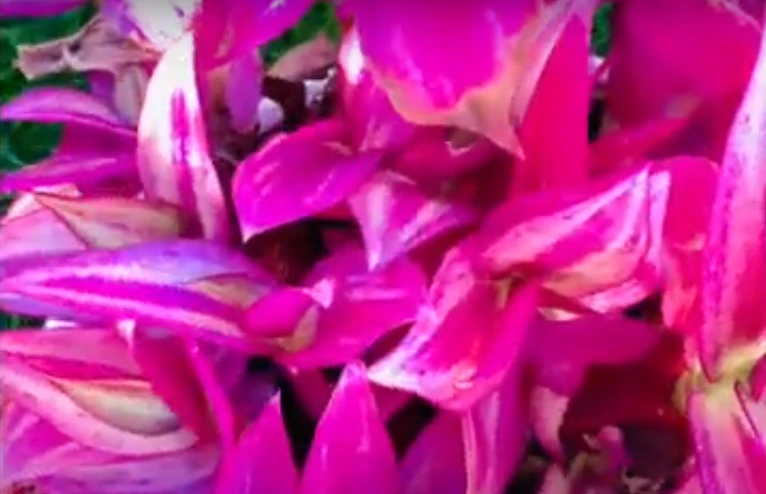
Growing Tradescantia Blushing Bride
Now that we’ve drooled over blushing bride spiderwort’s assets, let’s get down to the business of growing this beauty! From light and soil needs to propagation and more, providing the right care is key to success with Tradescantia blushing bride.
I’ll cover all the key cultivation must-knows so you can grow her like a pro:
Light Requirements
When it comes to illumination, think “bright but sheltered” for blushing bride spiderwort. Tradescantia blushing bride thrives with 4-6 hours of direct morning or evening sunlight daily. Midday sun is too intense and may scorch the thin leaves.
This spiderwort definitely leans more toward lower light requirements. In fact, mature specimens tolerate deep shade just fine too. Just don’t expect substantial flowering or much new growth. Part shade, under tall trees or lightly shaded porches, works wonderfully to keep this beauty happy!
Blushing bride spiderwort also adapts well to indoor settings. Position potted plants a few feet from a bright sunny window. Turn the pots every few days to promote balanced growth.
The key is providing consistent moisture as well as shelter from intense sunlight. Let those lovely blush-toned shoots keep unfurling!
Soil, Water and Fertilizer
When grown in the garden, Tradescantia blushing bride isn’t overly fussy about soil. Moist, rich soil amended with lots of organic compost serves it best. But blushing bride will tolerate most average garden conditions.
This spiderwort prefers consistently damp soil. Allow the top inch to dry between waterings. Prolonged soggy conditions invite rot and disease, so incorporate plenty of drainage materials like bark, charcoal and gravel into the soil mix.
Feed container plants with a balanced liquid fertilizer every 2-4 weeks during the growing season for lush growth. Outdoor plants usually get enough nutrients from rich soil and regular compost applications. But a water soluble fertilizer feed every couple months doesn’t hurt!
Hardiness and Growing Zones
One of the charms of Tradescantia blushing bride is its winter hardiness. It survives freezing winters even in zone 4 with ease! Just cut back frost burned foliage in late winter. Then blushing bride spiderwort resumes fresh growth once temperatures climb.
In zones 9 and warmer, blushing bride may die back to the roots during summer heat but regrows vigorously when cooler weather returns.
Gardeners across most of the continental US can incorporate this jewel into their landscapes. Blushing bride also grows beautifully in pots that shift into sheltered areas during extreme cold or heat.
Propagation and Pruning
Tradescantia Blushing bride spiderwort propagates efficiently from plant divisions in spring or cuttings throughout the growing months. Simply break off a side shoot with some roots attached or snip off a stem section. Put it directly in moist soil and soon a new robust plant forms!
To keep blushing bride plants looking fresh and encourage more bicolored new growth, pruning strategically is key. Clip off spent flowers as they fade to direct energy toward new buds. Also periodically remove any damaged or faded existing foliage. Snipping back overly long shoots helps the plant stay full and compact.
Problems and Solutions
While certainly easier to grow than many plants, the Tradescantia blushing bride spiderwort can encounter a few issues. Let’s go over some potential problems and solutions to keep your blushing bride thriving!
Pests
Spider mites, aphids, and other small piercing-sucking insects occasionally suck juices from blushing bride’s graceful foliage and stems. Mealybugs and scales may take up residence in hidden nooks on the stems and undersides of leaves.
While not foolproof, providing good culture like consistent moisture and fertilizer keeps blushing bride vigorous enough to withstand minor insect attacks. Quickly hosing plants down with a strong spray of water can dislodge many soft-bodies pests.
For heavy infestations, apply gentle insecticidal soap or neem oil as directed on the product labels. Isolate affected plants away from uninfested ones while treating to prevent spreading insects.
Slugs and snails can nibble blushing bride spiderwort too, especially young shoots and unfurling leaves. Scatter abrasive diatomaceous earth around the crown of plants. Set out shallow dishes of beer near plants to attract and drown these soft-bodied pests. Check under leaves and remove any pests you spot manually to prevent extensive damage.
Diseases
If allowed to sit in soggy soil, Tradescantia blushing bride – like most plants – may succumb to root rot diseases. Prevent issues by amending planting areas to improve drainage or repotting container plants in soil-less potting media. Discard any portions of plants with mushy black roots as they won’t recover.
Foliar spots and blights may deface leaves exposed to overhead watering or rain storms. Improve airflow and reduce dampness with proper spacing and pruning. Remove and destroy badly infected foliage to limit spread. As a last resort apply fungicidal sprays to protect plants but avoid excessive application.
Viruses sometimes cause unusual streaking, distortions, or stunted growth. Aphids and related sucking insects spread viruses as they feed. Control insects immediately upon detection and consider replacing badly infected plants. Ensure tools are decontaminated between plants with a 10% bleach solution to avoid transmitting viruses.
By taking proactive prevention measures and providing ideal growing conditions, you can avoid most problems with blushing bride spiderwort!
Environmental & Cultural Issues
If environmental factors get out of whack, blushing bride spiderwort growth can suffer. Here are some common cultural issues and solutions:
Problem: Leggy, weak growth with few flowers
Solution: Increase sunlight exposure, fertilize regularly
Problem: Loss of pink variegation in foliage
Solution: Provide bright light with some direct sun
Problem: Wilting, death of entire plant
Solution: Check soil moisture and drainage; amend conditions as needed
Monitor blushing bride spiderwort regularly to spot any cultural issues right away. Customize care to keep your plant happy in its environment! Proper ongoing maintenance nip most problems in the bud.
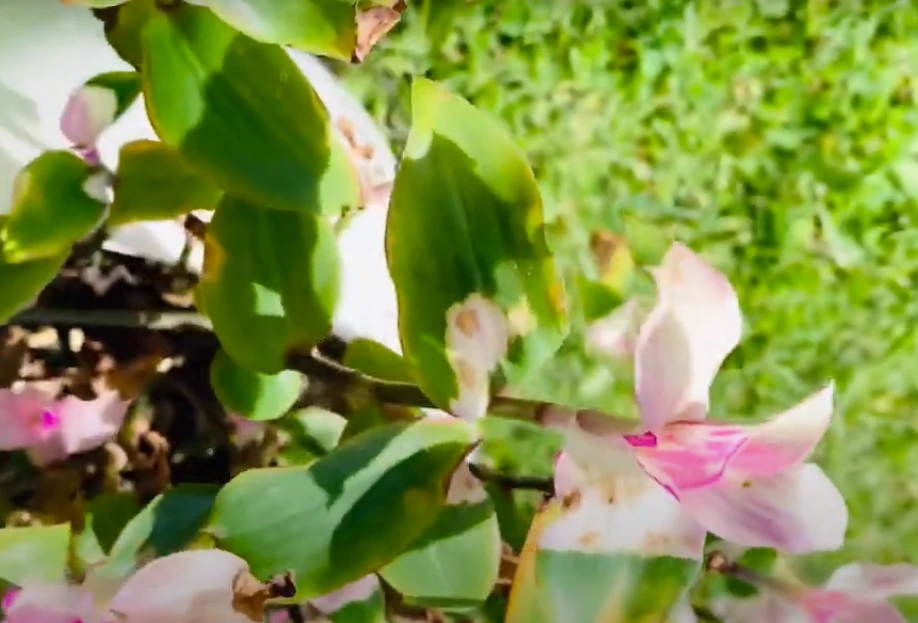
Uses in the Landscape and Gardens
Now that we’ve covered growing needs for Tradescantia blushing bride and its rugged cousin, T. occidentalis, let’s explore all the wonderful ways to incorporate them into gardens! From beds and borders to container designs, blushing bride and western spiderwort add a pop of lush color and texture.
Here are some excellent uses for both varieties in landscaping and garden areas:
Groundcovers: Both spiderwort varieties spread slowly without getting aggressive and crowd out other plants. Use them as living mulch under trees or fill hanging baskets to create cascading foliage.
Borders & Beds: Tuck Tradescantia blushing bride and T. occidentalis along walkways and the edges of garden beds. They create a graceful contrast around blooming perennials and provide striking color after spring bulbs fade.
Containers & Hanging Baskets: With their trailing and mounded habits, spiderworts make fabulous container components. Mix them with annuals like petunias or contrast with bold foliage. Trailing spiderworts spill beautifully from suspended pots.
Pollinator Gardens & Meadows: Don’t overlook the important role of spiderworts for our bee, butterfly and hummingbird friends! These perennials supply nectar while their shallow, clustered blooms allow small pollinators easy access to the bounty. Plant spiderworts in wildflower meadows and bee habitats.
Naturalized Areas: Given spiderworts’ hardy resilience and low maintenance reputation, they’re ideal for naturalizer plantings. Allow spiderworts like T. occidentalis to wander and fill in areas in part shade with little supplemental watering or care required.
Cut Flowers: Slice some of those charming spiderwort stems and display their complex blossoms in arrangements indoors too! Individual flowers only last about a day but the clusters supply plenty to go around.
Beyond useful, both spiderwort varieties we covered also happen to be incredibly beautiful. That combination surely cements them as top notch landscape plants! Blend them into your existing beds or showcase spiderworts in specimen containers.
Frequently Asked Questions
Growing and caring for gorgeous spiderwort varieties like Tradescantia blushing bride does come with a few common conundrums. Let’s dive into some of the questions I encounter frequently about getting the most out of these plants:
How do you make Tradescantia blushing bride pink?
Encouraging that fabulous pink variegation in the leaves relies on providing the right balance of sunlight, moisture, and fertility. Tradescantia blushing bride’s foliage pigments (anthocyanins) accumulate best in cool, bright conditions. Give plants bright filtered light or a few hours of direct sun in early spring and continue consistent moisture. Adding phosphorous fertilizer supports colorful leaves too.
Does Tradescantia need direct sunlight?
While they tolerate some direct sun, too much midday intensity can burn Spiderworts’ slender leaves. For best growth provide Tradescantia 4-6 hours of morning or evening direct sun with shelter from hot afternoon rays. Many do well in part shade too. Adjust sun exposure by seasons as needed.
Why is my blushing bride Tradescantia all green?
If established plants lose their pink variegation and turn all green, it’s likely due to insufficient light intensity reaching the leaves. New growth emerges colorful then matures to solid green in summer. Ensure plants get the brightest light possible without scalding afternoon sun. Prune back green foliage to allow fresh shoots. Supplemental fertilizer maintains leaf pigments too.
How do I get my Tradescantia to bloom?
Getting those delightful small 3-petaled blossoms over summer requires adequate sunlight along with consistent soil moisture and occasional fertilizer. At least 4 hours of direct sun fuels flowering. Deadhead spent blooms to promote more buds. Very shade grown or neglected specimens may display only foliage. Tweak care to support blooms!
What is the scientific name for Tradescantia Blushing Bride?
The full scientific name is Tradescantia x andersoniana ‘Blushing Bride’. The x indicates it’s an interspecific hybrid within the Tradescantia genus. ‘Blushing Bride’ denotes the cultivar or cultivated variety
Concluding Thoughts
Hopefully this guide gives you ample tips and tricks to keep your plants happy. Adjust care to manipulate spiderwort growth and displays. With the proper location and some attention, they generously reward us with charming flowers and graceful color.
If questions pop up along your spiderwort growing adventures, don’t hesitate to ask! I’m always happy to chat plants and help troubleshoot issues. Here’s to a thriving, vibrant garden full of spiderwort delights!


